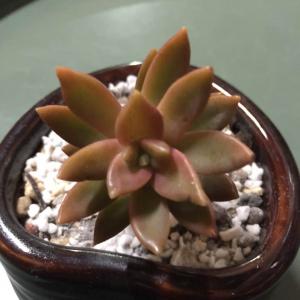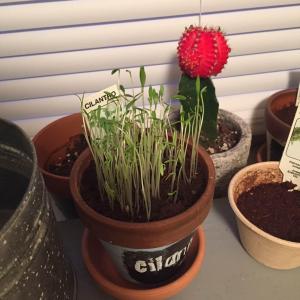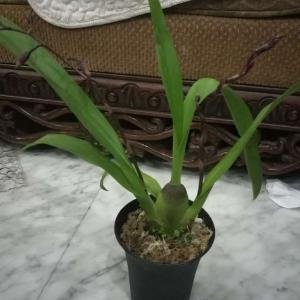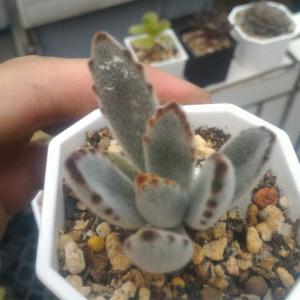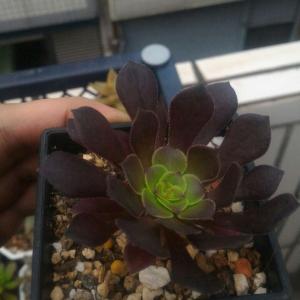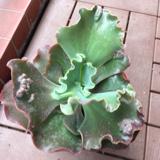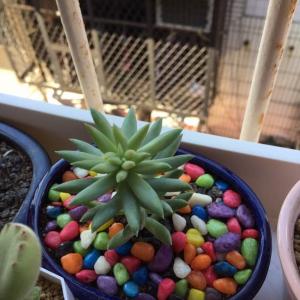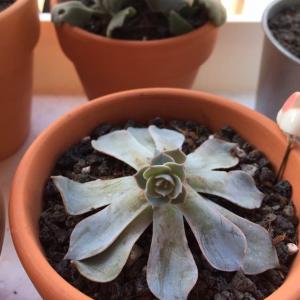文章
Miss Chen
2018年01月18日

Description: This is a biennial plant that becomes 2-5' tall during its second year. During the first year, a rosette of spreading to ascending basal leaves develops that is up to 1' across. Individual basal leaves are up to 6" long and 2" across; they are elliptic-oblanceolate to obovate in shape, while their margins are unlobed to shallowly pinnatifid, occasionally sinuous (horizontally wavy), and dentate-prickly. During the second year, this plant develops an erect central stem that is unbranched below, while branching occasionally above. The stems are light green, terete, glabrous, and often glaucous. Alternate leaves occur along the entire length of these stems, becoming gradually smaller above; their blades are widely spreading to ascending. The blades of these alternate leaves are up to 8" long and 2" across; they are elliptic-oblanceolate to oblanceolate in shape, while their margins are unlobed to moderately pinnatifid, occasionally sinuous, and dentate-prickly.
The upper surface of both basal and alternate leaves is yellowish green to medium green, glabrous and sometimes glaucous, while their lower surface is light green, glabrous, and sometimes glaucous. In addition, abundant prickles occur along the central vein of the lower leaf surface, while sparse prickles sometimes occur along the major lateral veins. The bases of alternate leaves clasp their stems with short rounded auricles (ear-like basal lobes) that are dentate-prickly and occasionally sinuous. The tips of these leaves are bluntly angled to acute. Both the stems and leaves of this plant contain a brown latex. The central stem and sometimes upper lateral stems terminate in panicles of flowerheads; these panicles are variable in size, but on larger plants they become up to 1½' long and 1' across. The branches of each inflorescence are more slender than the stems, otherwise they share similar characteristics. Small bractlets occur where these branches divide. The flowerheads often fail to open, but they are self-fertile. Those flowerheads that do open (on bright sunny days during the morning), can vary considerably in size, depending on the local ecotype; their diameter varies from 4-6 mm. in some areas to 12-18 mm. in other areas. Each flowerhead has 20-55 widely spreading ray florets and no disk florets. The petaloid rays of the flowerhead are narrowly oblong in shape; their tips are truncate and 5-toothed. The petaloid rays are usually light blue, but sometimes they are white to yellow. The tips of the petaloid rays, where the teeth occur, are often pale bronze.

The bases of flowerheads (involucres) are up to 15-20 mm. long and cylindrical-lanceoloid to lanceoloid in shape; they achieve their maximum size shortly after blooming. Around the base of each flowerhead, the floral bracts (involucral bracts) are arranged in several series; inner floral bracts are longer than outer floral bracts. They are linear-lanceolate in shape (upper-inner bracts) to ovate in shape (lower-outer bracts) and appressed together; these bracts are light green with white to purplish red margins, and they are glabrous. The blooming period occurs during the summer and early autumn, lasting 1½–3 months. Afterwards, the flowerheads are replaced by dense clusters of achenes. Mature achenes are about 4 mm. long, broadly ellipsoid-flattened in shape, and black mottled with brown; each side of an achene has a single central rib (less often 2-3 ribs). At the apex of each achene, there is a white thread-like beak about 4 mm. long, and attached to the apex of this beak is a tuft of white hairs spanning about 15-20 mm. across (individual hairs are 7-10 mm. long). These achenes are distributed by the wind. The root system consists of a taproot. This plant spreads by reseeding itself.

Cultivation: The preference is full sun, mesic to dry conditions, and soil containing sandy loam, loam, clay-loam, or loess. First-year rosettes of basal leaves may die down during winter, but new leaves are regenerated from the taproot during the spring. Open ground with exposed topsoil facilitates germination of the seed. Cultivation of this plant is not difficult, but it is rather weedy-looking and its flowerheads often fail to open.
Range & Habitat: The native Prairie Lettuce is rare in Illinois and state-listed as 'endangered.' It has been found primarily in the northern and west-central sections of the state (see Distribution Map). Illinois lies along the eastern range-limit of this species; it is more common in many areas of central and western United States. Populations of Prairie Lettuce have declined in Illinois, where it is found in such habitats as mesic to dry prairies and hill prairies. Disturbed areas of high quality natural habitats (mainly prairies) are preferred. This wildflower probably benefits from the disturbance provided by occasional wildfires and grazing by American Bison; this animal prefers to graze on grasses rather than forbs.

Faunal Associations: Little is known specifically about the relationships of Prairie Lettuce to various fauna. The flowerheads of this plant are probably cross-pollinated by various long-tongued and short-tongued bees. Insects that feed destructively on both cultivated and various species of wild lettuce (Lactuca spp.) consist primarily of aphids and larvae of polyphagous moths. The webmaster observed unidentified blackish aphids feeding on the upper stems and inflorescence branches of Prairie Lettuce. Both White-tailed Deer and the Cottontail Rabbit occasionally browse on the foliage of this plant; the latter animal fed on some of the basal leaves of Prairie Lettuce while it was being cultivated in a garden by the webmaster.
Photographic Location: The wildflower garden of the webmaster in Urbana, Illinois.

Comments: There are several native and non-native lettuce species (Lactuca spp.) that exist as wildflowers in Illinois. Most of these species are similar in appearance and they can be difficult to distinguish; the presence of both flowerheads and achenes are often required for correct identification. Prairie Lettuce (Lactuca ludoviciana) can be distinguished from many lettuce species by the brown latex of its foliage (rather than white latex). The rays of its flowerheads are often blue, rather than yellow, and the involucres (bract-covered bases) of these flowerheads are usually larger in size (up to 15-20 mm. long). The achenes of Prairie Lettuce have single-ribbed sides (less often 2-3 ribbed) and they have long thread-like beaks that are attached to relatively large tufts of hair (15-20 mm. across). A common Eurasian species, Prickly Lettuce (Lactuca serriola), differs from Prairie Lettuce by having flowerheads with pale yellow rays only (never blue), shorter involucres (up to 10-12 mm. long), and achenes with 5-7 ribs per side, to which are attached smaller tufts of white hair (only 7-10 mm. across).

A common native species, Lactuca canadensis (Wild Lettuce), differs by having leaves that lack stiff prickles along their margins, flowerheads with yellow to orange-yellow rays (never blue), shorter involucres (up to 10-15 mm. long), and achenes with smaller tufts of white hair (10-14 mm. across). Another native species, Lactuca biennis (Tall Blue Lettuce), has shorter involucres (up to 8-10 mm. long), achenes with 5-6 ribs per side, very short or no beaks on the achenes, and smaller tufts of hair (10-12 mm. across) that are light brown, rather than white. Another native species, Lactuca florida (Woodland Blue Lettuce), differs by having leaves with triangular-shaped terminal lobes, shorter involucres (up to 10-12 mm. long), achenes with 5-6 ribs per side, very short or no beaks on its achenes, and smaller tufts of white hair (8-10 mm. across). An uncommon native species, Lactuca hirsuta (Hairy Wild Lettuce), differs from Prairie Lettuce by having hairy stems, hairy leaves with ciliate margins, and flowerheads that sometimes have reddish rays, rather than yellow.
The upper surface of both basal and alternate leaves is yellowish green to medium green, glabrous and sometimes glaucous, while their lower surface is light green, glabrous, and sometimes glaucous. In addition, abundant prickles occur along the central vein of the lower leaf surface, while sparse prickles sometimes occur along the major lateral veins. The bases of alternate leaves clasp their stems with short rounded auricles (ear-like basal lobes) that are dentate-prickly and occasionally sinuous. The tips of these leaves are bluntly angled to acute. Both the stems and leaves of this plant contain a brown latex. The central stem and sometimes upper lateral stems terminate in panicles of flowerheads; these panicles are variable in size, but on larger plants they become up to 1½' long and 1' across. The branches of each inflorescence are more slender than the stems, otherwise they share similar characteristics. Small bractlets occur where these branches divide. The flowerheads often fail to open, but they are self-fertile. Those flowerheads that do open (on bright sunny days during the morning), can vary considerably in size, depending on the local ecotype; their diameter varies from 4-6 mm. in some areas to 12-18 mm. in other areas. Each flowerhead has 20-55 widely spreading ray florets and no disk florets. The petaloid rays of the flowerhead are narrowly oblong in shape; their tips are truncate and 5-toothed. The petaloid rays are usually light blue, but sometimes they are white to yellow. The tips of the petaloid rays, where the teeth occur, are often pale bronze.

The bases of flowerheads (involucres) are up to 15-20 mm. long and cylindrical-lanceoloid to lanceoloid in shape; they achieve their maximum size shortly after blooming. Around the base of each flowerhead, the floral bracts (involucral bracts) are arranged in several series; inner floral bracts are longer than outer floral bracts. They are linear-lanceolate in shape (upper-inner bracts) to ovate in shape (lower-outer bracts) and appressed together; these bracts are light green with white to purplish red margins, and they are glabrous. The blooming period occurs during the summer and early autumn, lasting 1½–3 months. Afterwards, the flowerheads are replaced by dense clusters of achenes. Mature achenes are about 4 mm. long, broadly ellipsoid-flattened in shape, and black mottled with brown; each side of an achene has a single central rib (less often 2-3 ribs). At the apex of each achene, there is a white thread-like beak about 4 mm. long, and attached to the apex of this beak is a tuft of white hairs spanning about 15-20 mm. across (individual hairs are 7-10 mm. long). These achenes are distributed by the wind. The root system consists of a taproot. This plant spreads by reseeding itself.

Cultivation: The preference is full sun, mesic to dry conditions, and soil containing sandy loam, loam, clay-loam, or loess. First-year rosettes of basal leaves may die down during winter, but new leaves are regenerated from the taproot during the spring. Open ground with exposed topsoil facilitates germination of the seed. Cultivation of this plant is not difficult, but it is rather weedy-looking and its flowerheads often fail to open.
Range & Habitat: The native Prairie Lettuce is rare in Illinois and state-listed as 'endangered.' It has been found primarily in the northern and west-central sections of the state (see Distribution Map). Illinois lies along the eastern range-limit of this species; it is more common in many areas of central and western United States. Populations of Prairie Lettuce have declined in Illinois, where it is found in such habitats as mesic to dry prairies and hill prairies. Disturbed areas of high quality natural habitats (mainly prairies) are preferred. This wildflower probably benefits from the disturbance provided by occasional wildfires and grazing by American Bison; this animal prefers to graze on grasses rather than forbs.

Faunal Associations: Little is known specifically about the relationships of Prairie Lettuce to various fauna. The flowerheads of this plant are probably cross-pollinated by various long-tongued and short-tongued bees. Insects that feed destructively on both cultivated and various species of wild lettuce (Lactuca spp.) consist primarily of aphids and larvae of polyphagous moths. The webmaster observed unidentified blackish aphids feeding on the upper stems and inflorescence branches of Prairie Lettuce. Both White-tailed Deer and the Cottontail Rabbit occasionally browse on the foliage of this plant; the latter animal fed on some of the basal leaves of Prairie Lettuce while it was being cultivated in a garden by the webmaster.
Photographic Location: The wildflower garden of the webmaster in Urbana, Illinois.

Comments: There are several native and non-native lettuce species (Lactuca spp.) that exist as wildflowers in Illinois. Most of these species are similar in appearance and they can be difficult to distinguish; the presence of both flowerheads and achenes are often required for correct identification. Prairie Lettuce (Lactuca ludoviciana) can be distinguished from many lettuce species by the brown latex of its foliage (rather than white latex). The rays of its flowerheads are often blue, rather than yellow, and the involucres (bract-covered bases) of these flowerheads are usually larger in size (up to 15-20 mm. long). The achenes of Prairie Lettuce have single-ribbed sides (less often 2-3 ribbed) and they have long thread-like beaks that are attached to relatively large tufts of hair (15-20 mm. across). A common Eurasian species, Prickly Lettuce (Lactuca serriola), differs from Prairie Lettuce by having flowerheads with pale yellow rays only (never blue), shorter involucres (up to 10-12 mm. long), and achenes with 5-7 ribs per side, to which are attached smaller tufts of white hair (only 7-10 mm. across).

A common native species, Lactuca canadensis (Wild Lettuce), differs by having leaves that lack stiff prickles along their margins, flowerheads with yellow to orange-yellow rays (never blue), shorter involucres (up to 10-15 mm. long), and achenes with smaller tufts of white hair (10-14 mm. across). Another native species, Lactuca biennis (Tall Blue Lettuce), has shorter involucres (up to 8-10 mm. long), achenes with 5-6 ribs per side, very short or no beaks on the achenes, and smaller tufts of hair (10-12 mm. across) that are light brown, rather than white. Another native species, Lactuca florida (Woodland Blue Lettuce), differs by having leaves with triangular-shaped terminal lobes, shorter involucres (up to 10-12 mm. long), achenes with 5-6 ribs per side, very short or no beaks on its achenes, and smaller tufts of white hair (8-10 mm. across). An uncommon native species, Lactuca hirsuta (Hairy Wild Lettuce), differs from Prairie Lettuce by having hairy stems, hairy leaves with ciliate margins, and flowerheads that sometimes have reddish rays, rather than yellow.
0
0
文章
Miss Chen
2018年01月18日

Description: This is a low spreading shrub up to 1½' tall and 20' across. The bark of the short trunk and larger branches is brown to gray, exfoliating into strips. The bark of branchlets (about ¼–½" across) is brown and smooth, while young shoots are yellowish green to pale blue and glabrous. Along the shoots and young branchlets, scale-like leaves are arranged in 4 partially overlapping ranks; they are appressed together. These leaves are 1.5–8 mm. long and 1–3 mm. across; they are usually smallest toward the tips of young shoots, becoming larger in size as they age, until they turn brown and wither away. However, on particularly vigorous shoots of mature shrubs, the leaves at the tips of young shoots are longer. The scale-like leaves are green, bluish green, or grayish blue, lanceolate in shape, toothless along their margins, glabrous, and sometimes glaucous. The leaves are also evergreen, although they often become pale reddish purple during the winter. The outer sides of the leaves are convex. Because Creeping Juniper is dioecious, male (staminate) and female (pistillate) cones are produced at the tips of shoots on separate shrubs during late spring or summer. Each male cone has a cluster of yellowish stamens up to 5 mm. long. Each female cone consists of a cluster of small scales during its first year of development. Cross-pollination is accomplished by the wind. During the second year of development, each female cone becomes berry-like in appearance. At maturity, berry-like cones are 5-8 mm. across, more or less globoid in shape, and light blue from a glaucous coating. The interior of individual cones contains a stiff pulp that is resinous, and usually 1-3 seeds. Individual seeds are 3-5 mm. long and more or less ovoid in shape, although they are flat along one side and irregularly ridged. The root system is woody, shallow, and widely spreading. Creeping Juniper reproduces primarily by layering when above-ground branches dip into the ground, forming their own roots, and later detaching from the original shrub. Eventually, this process results in a colony of clonal shrubs. Less often, Creeping Juniper reproduces by reseeding itself.

Cultivation: The preference is full sun, relatively dry and well-drained conditions, and a calcareous soil containing sand or rocky material. This shrub can adapt to fertile soil containing loam or clay-loam, but taller plants should be kept away from it. This shrub is slow-growing, and in the wild it typically lives 20-140 years (Gucker, 2006). It tolerates hot weather during the summer and severe cold during the winter. Like Eastern Red Cedar (Juniperus virginiana), Creeping Juniper is a potential host plant of a fungal disease, cedar-apple rust.
Range & Habitat: Creeping Juniper is a rare shrub in Illinois, where it is restricted to sandy areas along Lake Michigan (see Distribution Map), and it is state-listed as 'endangered.' Most botanists within the state regard this shrub as native. Illinois lies along the southern range-limit of this species; Creeping Juniper is more common further to the north in Wisconsin and Canada. Within Illinois, habitats include partially stabilized sand dunes and upland sand prairies. Outside of the state, it is also found along the rocky slopes of Cedar glades, cliffs, and sandy pastures. Creeping Juniper is found in high quality natural areas in Illinois. It is also widely cultivated as an evergreen ground cover. While its foliage is initially reluctant to burn, this shrub is killed by wildfire, as its thin bark provides little protection (Gucker, 2006).
Faunal Associations: Creeping Juniper is a host plant of various insects that feed on the foliage or sap. These species include a flea beetle (Paria sexnotata), a plant bug (Bolteria luteifrons), two aphids (Cinara manitobensis, Cinara petersoni), a leafhopper (Texananus marmor), and larvae of two moths, the Juniper Webworm (Dichomeris marginella) and Red-striped Juniper Looper (Thera juniperata); see Clark et al. (2004), Wheeler et al. (1983), Blackman & Eastop (2013), DeLong (1926), Hamilton (1990), and Maier et al. (2011). Some of these insects have been found in Canada (e.g., Manitoba & Ontario) and the New England region, but not in Illinois. The berry-like cones and their seeds are eaten by some upland gamebirds and songbirds, including the Wild Turkey, White-winged Crossbill, Northern Flicker, Cedar Waxwing, American Robin, and Starling. Prairie Voles cache the berry-like cones and galls of Creeping Juniper in their dens for later eating, while Meadow Voles gnaw on the bark during the winter. White-tailed Deer browse on the evergreen foliage of this shrub, primarily during the winter and early spring, when palatable food is scarce (see Martin et al., 1951/1961; Gucker, 2006).
Photographic Location: Along a sidewalk in Champaign, Illinois.

Comments: The remarkable thing about this shrub is how low and spreading it is. Creeping Juniper (Juniperus horizontalis) is closely related to the Eastern Red Cedar (Juniperus virginianus) as these two species can hybridize with each other. Such hybrids exist in the wild in the driftless section of southwest Wisconsin, for example, and they are also cultivated for landscaping purposes. These two species share the same scaly leaves and blue berry-like seed cones. However, Eastern Red Cedar is a tree, rather than a low spreading shrub. Another species, Common Juniper (Juniperus communis), differs from the preceding species by its needle-like leaves, and its seed cones require three years to develop, rather than two. Creeping Juniper is widely regarded as native to the lakeshore area of NE Illinois. However, Tehon (1942) regarded this shrub as non-native, stating that "Creeping Juniper or Creeping Savin, though not native to Illinois, was seeded on the Waukegan moorland nearly three-quarters of a century ago [about 1870] and now occurs there as an established naturalized species." He further states: "On the Waukegan moorland, it has developed from the original seeding as a low trailing shrub with bright steel-blue foliage which, in autumn, turns pale purple and becomes glaucus."

Cultivation: The preference is full sun, relatively dry and well-drained conditions, and a calcareous soil containing sand or rocky material. This shrub can adapt to fertile soil containing loam or clay-loam, but taller plants should be kept away from it. This shrub is slow-growing, and in the wild it typically lives 20-140 years (Gucker, 2006). It tolerates hot weather during the summer and severe cold during the winter. Like Eastern Red Cedar (Juniperus virginiana), Creeping Juniper is a potential host plant of a fungal disease, cedar-apple rust.
Range & Habitat: Creeping Juniper is a rare shrub in Illinois, where it is restricted to sandy areas along Lake Michigan (see Distribution Map), and it is state-listed as 'endangered.' Most botanists within the state regard this shrub as native. Illinois lies along the southern range-limit of this species; Creeping Juniper is more common further to the north in Wisconsin and Canada. Within Illinois, habitats include partially stabilized sand dunes and upland sand prairies. Outside of the state, it is also found along the rocky slopes of Cedar glades, cliffs, and sandy pastures. Creeping Juniper is found in high quality natural areas in Illinois. It is also widely cultivated as an evergreen ground cover. While its foliage is initially reluctant to burn, this shrub is killed by wildfire, as its thin bark provides little protection (Gucker, 2006).
Faunal Associations: Creeping Juniper is a host plant of various insects that feed on the foliage or sap. These species include a flea beetle (Paria sexnotata), a plant bug (Bolteria luteifrons), two aphids (Cinara manitobensis, Cinara petersoni), a leafhopper (Texananus marmor), and larvae of two moths, the Juniper Webworm (Dichomeris marginella) and Red-striped Juniper Looper (Thera juniperata); see Clark et al. (2004), Wheeler et al. (1983), Blackman & Eastop (2013), DeLong (1926), Hamilton (1990), and Maier et al. (2011). Some of these insects have been found in Canada (e.g., Manitoba & Ontario) and the New England region, but not in Illinois. The berry-like cones and their seeds are eaten by some upland gamebirds and songbirds, including the Wild Turkey, White-winged Crossbill, Northern Flicker, Cedar Waxwing, American Robin, and Starling. Prairie Voles cache the berry-like cones and galls of Creeping Juniper in their dens for later eating, while Meadow Voles gnaw on the bark during the winter. White-tailed Deer browse on the evergreen foliage of this shrub, primarily during the winter and early spring, when palatable food is scarce (see Martin et al., 1951/1961; Gucker, 2006).
Photographic Location: Along a sidewalk in Champaign, Illinois.

Comments: The remarkable thing about this shrub is how low and spreading it is. Creeping Juniper (Juniperus horizontalis) is closely related to the Eastern Red Cedar (Juniperus virginianus) as these two species can hybridize with each other. Such hybrids exist in the wild in the driftless section of southwest Wisconsin, for example, and they are also cultivated for landscaping purposes. These two species share the same scaly leaves and blue berry-like seed cones. However, Eastern Red Cedar is a tree, rather than a low spreading shrub. Another species, Common Juniper (Juniperus communis), differs from the preceding species by its needle-like leaves, and its seed cones require three years to develop, rather than two. Creeping Juniper is widely regarded as native to the lakeshore area of NE Illinois. However, Tehon (1942) regarded this shrub as non-native, stating that "Creeping Juniper or Creeping Savin, though not native to Illinois, was seeded on the Waukegan moorland nearly three-quarters of a century ago [about 1870] and now occurs there as an established naturalized species." He further states: "On the Waukegan moorland, it has developed from the original seeding as a low trailing shrub with bright steel-blue foliage which, in autumn, turns pale purple and becomes glaucus."
0
0
文章
Miss Chen
2018年01月17日

Description: This perennial plant is up to 2½' tall, branching occasionally in the upper half. The hairless stems are red or green. The hairless opposite leaves are up to 2½" long and 1" across. They are oblong, oval, or bluntly lanceolate (with rounded tips), with a few pinnate or parallel veins and smooth margins. The leaves are often sessile or perfoliate, otherwise they have short petioles. Scattered translucent dots are observable on the underside of the leaves. Smaller leaves often appear in the upper axils of the larger leaves on major stems. Many of these stems terminate in tight clusters of yellow flowers. Each flower is a little less than ½" across, and has 5 petals. In the center, is a flask-shaped pistil that is surrounded by numerous yellow anthers on long styles. Numerous small dark dots can occur anywhere on the surface of the petals or the buds, often appearing in streaks. There is no floral scent. The blooming period occurs during mid-summer and lasts about a month. The seedpods split into 3 sections, exposing numerous tiny seeds, which are scattered by the wind when the stems sway back and forth. The root system consists of a branching taproot and short rhizomes. Vegetative colonies of this plant can develop from the rhizomes.

Cultivation: The preference is full or partial sun, moist to mesic conditions, and a rather lean soil, which reduces competition from taller plants. Rocky or gravelly soil is quite acceptable. Occasionally, the leaves turn brown in response to drought, otherwise this plant has few problems.
Range & Habitat: Spotted St. John's Wort occurs in every county of Illinois, where it is fairly common and native (see Distribution Map). Habitats include moist to mesic black soil prairies, gravel prairies, open woodlands (rocky and otherwise), savannas, woodland borders, thickets, clay banks along rivers or lakes, and areas along roadsides and railroads.
Faunal Associations: The flowers attract long-tongued and short-tongued bees, including bumblebees and Halictid bees. Beetles and Syrphid flies may also visit the flowers, but they are less effective pollinators. The reward of these insects is the abundant pollen, as the flowers produce no nectar. The caterpillars of the butterfly Strymon melinus (Gray Hairstreak) reportedly eat the seed capsules, while the caterpillars of the moth Nedra ramosula (Gray Half-Spot) feed on the foliage. Mammalian herbivores usually don't consume this plant because the leaves contain hypericin – a photosensitive toxin. Light-skinned animals are especially sensitive to this toxin, which can cause the skin to blister in sunlight. It can also cause gastrointestinal irritation.
Photographic Location: The photographs were taken at Judge Webber Park in Urbana, Illinois.
Comments: The easiest way to distinguish Spotted St. John's Wort from other similar species involves an examination of the flower petals. Dark dots and streaks can appear anywhere on the upper surface of the yellow petals, whereas for other species of St. John's Wort such dots and streaks are confined near the margins of the petals, or they are completely absent. The common name of this plant refers to the feast day of St. John, which was celebrated in Medieval Europe at the time of the summer solstice (late June). This corresponded to the time when the European species Hypericum perforatum (Common St. John's Wort) typically blooms, and so the saint and wildflower became associated together.

Cultivation: The preference is full or partial sun, moist to mesic conditions, and a rather lean soil, which reduces competition from taller plants. Rocky or gravelly soil is quite acceptable. Occasionally, the leaves turn brown in response to drought, otherwise this plant has few problems.
Range & Habitat: Spotted St. John's Wort occurs in every county of Illinois, where it is fairly common and native (see Distribution Map). Habitats include moist to mesic black soil prairies, gravel prairies, open woodlands (rocky and otherwise), savannas, woodland borders, thickets, clay banks along rivers or lakes, and areas along roadsides and railroads.
Faunal Associations: The flowers attract long-tongued and short-tongued bees, including bumblebees and Halictid bees. Beetles and Syrphid flies may also visit the flowers, but they are less effective pollinators. The reward of these insects is the abundant pollen, as the flowers produce no nectar. The caterpillars of the butterfly Strymon melinus (Gray Hairstreak) reportedly eat the seed capsules, while the caterpillars of the moth Nedra ramosula (Gray Half-Spot) feed on the foliage. Mammalian herbivores usually don't consume this plant because the leaves contain hypericin – a photosensitive toxin. Light-skinned animals are especially sensitive to this toxin, which can cause the skin to blister in sunlight. It can also cause gastrointestinal irritation.
Photographic Location: The photographs were taken at Judge Webber Park in Urbana, Illinois.
Comments: The easiest way to distinguish Spotted St. John's Wort from other similar species involves an examination of the flower petals. Dark dots and streaks can appear anywhere on the upper surface of the yellow petals, whereas for other species of St. John's Wort such dots and streaks are confined near the margins of the petals, or they are completely absent. The common name of this plant refers to the feast day of St. John, which was celebrated in Medieval Europe at the time of the summer solstice (late June). This corresponded to the time when the European species Hypericum perforatum (Common St. John's Wort) typically blooms, and so the saint and wildflower became associated together.
0
0





